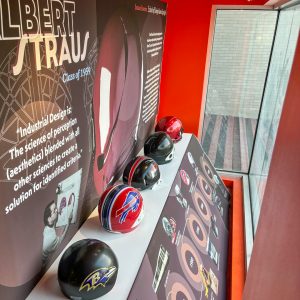
Witnessing a helmet-to-helmet collision sparked an idea for School of Design alumnus Bert Straus ’59, setting off a series of evolutions in headwear and protective sports equipment.
Straus remembers watching the collision during a televised sports game. An image of a giant pillow inserted at the helmet’s point of contact sprung into his mind.
The designer began sketching the concept, covering the helmet’s outer surface with a urethane foam shell. After prototyping and testing the concept, the ProCap was born.
A brief look into the designer’s extensive career can now be found at the Nancy Cantor Warehouse.
“The idea that we show just a glimpse of his work in the window vitrine looking out onto West Fayette Street was the impetus for this display,” says Don Carr, professor of industrial and interaction design. “As a graduate of the ID [industrial design] program from the class of 1959, he was able to share with us examples of amazing work from each decade, which we’ve displayed as a baseline for the installation.”
A sampling of helmets reveals the evolution of his design. “The first changes were driven by aesthetics,” Straus recalls. “It’s difficult for a designer to admit, but ProCap I was ugly. Working with the [Buffalo] Bills, I came up with ProCap II.”
The product evolved to meet the needs of the industry. When the market asked for a vented version, ProCap III was born. Keeping up with trends required further styling, coupled with the integration of the soft-shell technology into a full helmet design.
“The latest change was … prompted by the need to effectively protect against glancing blows that promote rotational accelerations, recognized as the cause of half the concussions suffered on the field,” says Straus.
More information about his work can be found at the Warehouse window display, 350 W. Fayette St., which will be up through mid-October.
Straus plans to visit Syracuse University this fall. He looks forward to meeting the students and hearing about their design aspirations.
“I also look forward to answering whatever questions they might have,” he notes. “Both the students and I have this rare opportunity to collectively look at our profession over a seven-decade span.”
